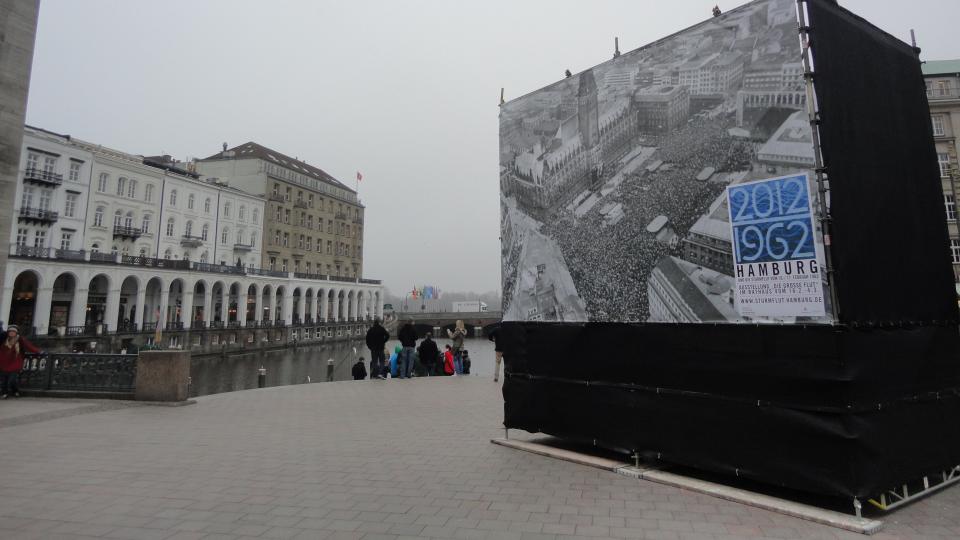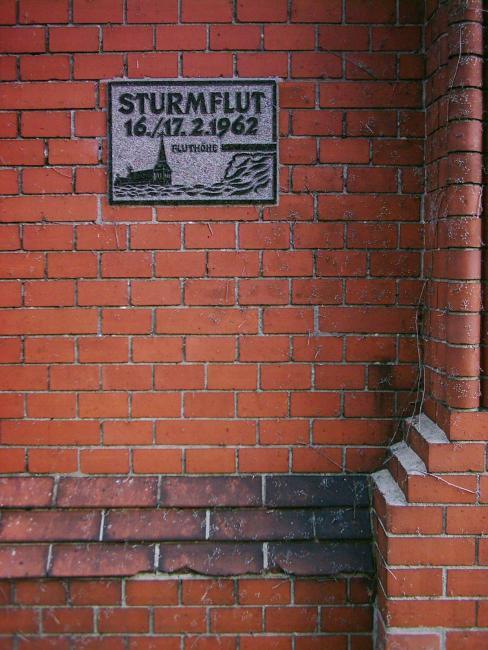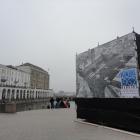On 20 February 1962, some 150,000 people gathered on Hamburg’s Rathausmarkt for a commemoration of the victims of the great flood that had inundated large parts of the city in the night of 16 and 17 February.

Temporary memorial during the 50th anniversary of the flood at Hamburg’s Rathausmarkt
Temporary memorial during the 50th anniversary of the flood at Hamburg’s Rathausmarkt
2012 Felix Mauch
 This work is licensed under a Creative Commons Attribution-NonCommercial-ShareAlike 3.0 Unported License.
This work is licensed under a Creative Commons Attribution-NonCommercial-ShareAlike 3.0 Unported License.
In his speech, Mayor Paul Nevermann formulated the first call for commemoration of the flood: “Only in the nights of bombing in the year 1943 and the fire of 1842 was our city hit by an affliction that was as grave as this last blow. This experience of suffering will act as both a warning and an exhortation.” This appeal did not go unheard, and became the starting point of a lasting memory culture surrounding the Great Flood. Disaster memory became a veritable duty. A committee of experts responsible for dealing with the disaster warned the city against the perils of not being constantly aware of potential danger. Memories of previous storm floods had faded away —the last major flood, which took place in 1825, had occurred more than one hundred years earlier— allowing people to forget about the possibility of recurrence. Collective memory became more than just commemoration. It provided not only a historic perspective, but also a perspective for the future, functioning as a medium through which to cope with the disaster and to warn against and prevent the next storm flood. Still today, commemoration events and medial or material acts of remembrance make up an integral part of local and national memory culture. Elements of this “memory landscape” include speeches, memorials, high water marks, signs, newspaper articles, photographs, and films.

Flood memorial in Hamburg-Oevelgoenne.
Flood memorial in Hamburg-Oevelgoenne.
Photograph by Felix Mauch, 2011
 This work is licensed under a Creative Commons Attribution-NonCommercial-ShareAlike 3.0 Unported License.
This work is licensed under a Creative Commons Attribution-NonCommercial-ShareAlike 3.0 Unported License.

High-water mark of the 1962 flood at a church in Hamburg-Moorburg.
High-water mark of the 1962 flood at a church in Hamburg-Moorburg.
Photograph by GeorgHH, 2006.
Image accessed via Wikimedia. Click here to view image source.
 This work is licensed under a Creative Commons Public Domain Mark 1.0 License.
This work is licensed under a Creative Commons Public Domain Mark 1.0 License.
Aside from the commemoration of victims and destruction caused by the flood, local and national identity was strongly influenced by memories of rescue operations, social cohesion in the wake of the flood, and successful reconstruction thereafter. Recently, memory culture has also developed “from below,” a trend visible in private initiatives and the personal archives of eyewitnesses who bear remembrance to and pass on memories of the flood.
How to cite
Mauch, Felix. “The Hamburg Flood in Public Memory Culture.” Environment & Society Portal, Arcadia (2011), no. 4. Rachel Carson Center for Environment and Society. https://doi.org/10.5282/rcc/2650.
ISSN 2199-3408
Environment & Society Portal, Arcadia
 This work is licensed under a Creative Commons Attribution-NonCommercial-ShareAlike 3.0 Unported License.
This work is licensed under a Creative Commons Attribution-NonCommercial-ShareAlike 3.0 Unported License.
2012 Felix Mauch
This refers only to the text and does not include any image rights.
Please click on the images to view their individual rights status.
- Bütow, Hans, ed. Die Große Flut in Hamburg. Eine Chronik der Katastrophe vom Februar 1962. Hamburg: Schulbehörde Freie und Hansestadt Hamburg, 1963.
- Kempe, Michael. “‘Mind the Next Flood!’ Memories of Natural Disasters in Northern Germany from the Sixteenth Century to the Present.” The Medieval History Journal 10, no. 1 (2007): 327–354.
- Mauelshagen, Franz. “Flood Disasters and Political Culture at the German North Sea Coast: A Long-term Historical Perspective.” Historical Social Research 32, no. 3 (2007): 133–144.
- Paech, Frauke. “‘Die ganzen menschlichen Geschichten.’ Die Hamburger Sturmflut von 1962 im Bewusstsein der Wilhelmsburger Bevölkerung.” In Wilhelmsburg: Hamburgs große Elbinsel, edited by Geschichtswerkstatt Wilhelmsburg Honigfabrik, 161–174. Hamburg: Medien-Verlag Schubert, 2008.
- Pfister, Christian. “‘The Monster Swallows You.’ Disaster Memory and Risk Culture in Western Europe, 1500–2000.” RCC Perspectives 2011, no. 1.








